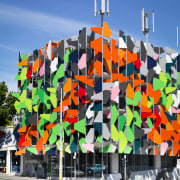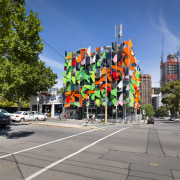Pulling the plug on tradition
A working prototype office building outstrips the coveted carbon-zero rating, creating carbon-neutral architecture that gives back everything it takes

Energy resources shrink, population numbers and greenhouse gas production leap under our ever-growing demands how can we contemplate even one more planet-sapping construction? Fortunately, there is a responsible way forward a new breed of architecture that not only treads lightly on the planet, but actually leaves no carbon footprint at all.
Once a symbol of Melbourne's rich historic past, the iconic Carlton Brewery site on Swanston Street is now the setting of an eco flagship for the future. Pixel designed by architectural firm studio505, sustainability experts Umow Lai and structural engineering firm VDM Consultants is the new Grocon development office for the substantial Carlton Brewery redevelopment at the same address.
Grocon's general manager of the Carlton Brewery project, David Waldren, says Pixel provides a local solution to the global problem of a carbon-constrained world.
"With a prospect of a carbon-linked economy in Australia in the form of carbon tax Pixel serves as a prototype for commercial design of the future."
Waldren is not overstating his case. Pixel goes beyond the growing number of carbon-zero builds which offset the carbon produced in running them with renewable energy, usually generated elsewhere. The carbon-neutral Pixel also offsets the carbon embodied in its building materials, as well as the carbon produced in its construction and uniquely, does so on its own site.
In Australasia, the vibrant Pixel has achieved a 6-Star Green Star rating and a staggering 100% Green Star score. Grocon and studio505 are also aiming to ace all green building code conventions in England and the United States. Pixel rated highest achiever to date on the US LEED rating tool and on the UK green building yardstick, BREEAM.
Studio505's project architect on Pixel, Dylan Brady, says the approach has been to address carbon issues up front, but also to undertake a thorough review of water harvesting, and building environment control.

"Offsetting carbon levels is achieved in several ways. Pixel achieves an extremely low level of base building carbon emissions it uses a special type of concrete, Pixelcrete, which halves the traditional levels of embodied carbon in the mix," says Brady. "The low levels of carbon emissions make it easier to get a carbon neutral outcome, as less renewable energy is required.
"However, it is Pixel's mechanical and electrical services, which are designed to emit very low levels of carbon, that make carbon neutrality achievable."
A central aspect of achieving the Green Star rating is the 100% fresh air systems and strategies employed in the building. These rely on the thermal integrity of a concrete-mass base structure and a thermally responsive building facade both of which Pixel enjoys.
Pixel's operational energy is significantly reduced through the use of active mass cooling (AMC), a system design that uses separate cooling and heating approaches. Cooling is via hydraulic pipe work embedded into the exposed structural slab, providing silent, radiant cooling, with ventilation and additional cooling coming from fresh air delivered through access floors. The thermal mass of the concrete slab allows it to soak up energy during the day without large fluctuations in internal temperature. In winter, the mass then absorbs the warmer air being expelled from the building, removing much of the building's requirement for heating.
In addition, free night cooling, or night purging, is achieved through smart window technology, operated by sophisticated building management software, that automatically opens the windows of the facade on cooler nights to enable the night air to flow into the building and cool the structure.
Besides using natural processes, Grocon imported a gas-fired absorption chiller to add to Pixel's green arsenal an idea originally from Umow Lai. Widely used elsewhere, but a first for Australia, the high-tech chiller uses ammonia as its refrigerant source and natural gas as its energy source. As a result of this technology, the carbon emissions from the air conditioning plant are dramatically lower when compared with electrically powered chiller systems. The use of ammonia as the refrigerant gas in the system means there is no ozone-depleting potential.
All this minimising of carbon emissions is balanced by the usual sustainable energy suspects three improved, and patented, wind turbines are complemented by photovoltaic panels mounted on a tracking device to follow the sun. There are also some fixed PV panels. One far more unusual resource takes the form of biogas, generated in an anaerobic digester from the blackwater off Pixel's vacuum toilet system this energy is used for domestic hot water heating.

Efficient use of water systems generally is another stand-out sustainable advantage for Pixel. The building is designed to be highly water efficient reducing water consumption to zero, with the only exception being drinkable water for staff.
"Strategies include low-use water fittings, such as the vacuum toilets, collection of rain water from the green roof for showers and hand basins, and a highly innovative approach to grey water usage.
"Grey water from showers and basins is moved through screens and filters before being channelled into the gravel substrate for planter boxes on the building's facade, where the plants' roots remove further impurities via microbiological actions. The water then moves through further cleaning treatments with little actually reaching the sewage system at the end," says Waldren.
Other attributes of Pixel include deep natural light penetration and eco glass, raised floors and localised climate control even the facade's multi-coloured flags that provide strategic shading are cut in such a way as to leave no material wastage. Then there was Grocon's and studio505's vigorous on-site recycling and education policy.
But Pixel's real pulling power for Grocon's future clients in Australia and around the world is that it showcases such a broad array of sustainable approaches all seen together in one place, on one extremely planet-friendly commercial building.
Credit list
Developer
Interior design
Civil engineer
Fire consultant
Landscaping
Cladding
Facade design/construction
Flooring
Ceiling
Lighting
BMS
Signage
Architect
Construction
Mechanical and electrical engineer
Quantity surveyor
Landscape supply
Roofing
Window/door joinery
Wall coverings
Blinds
Heating and cooling
Office furniture
Hydraulics
Story by: Charles Moxham
Home kitchen bathroom commercial design













